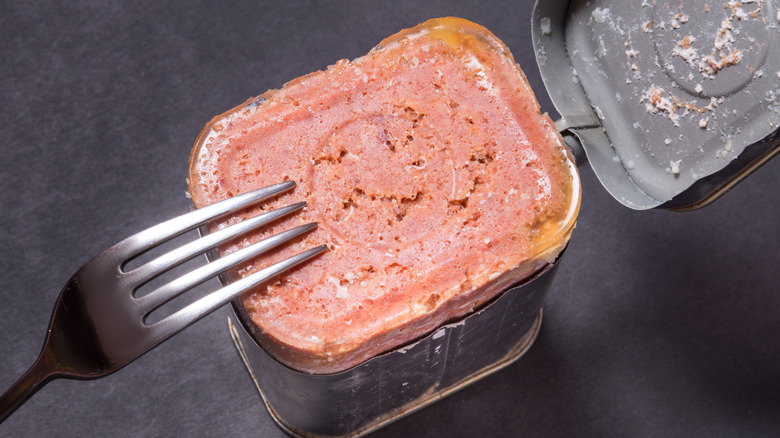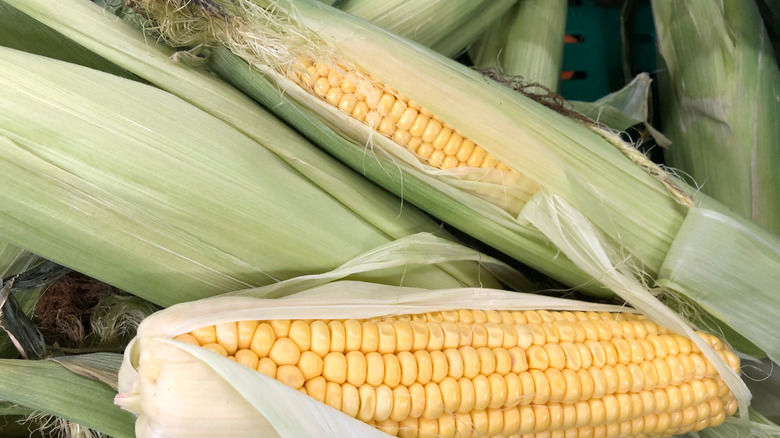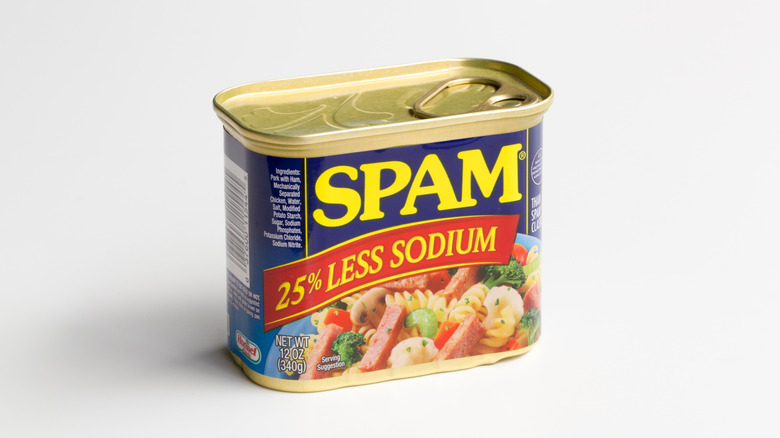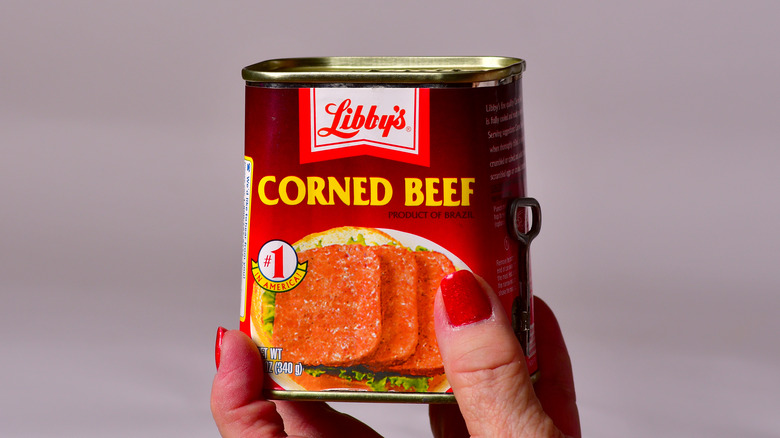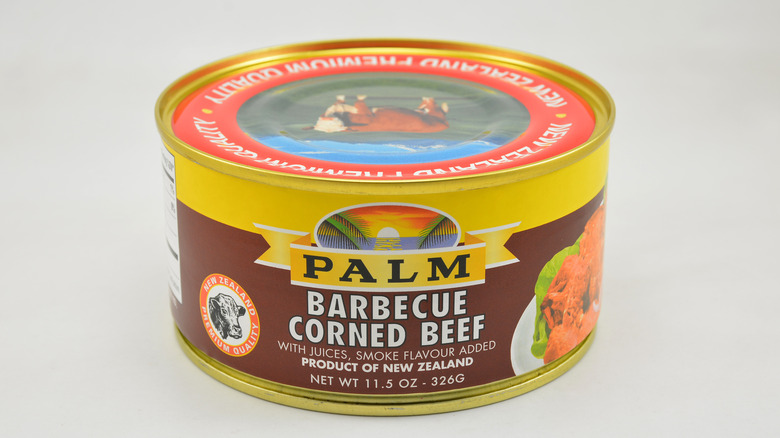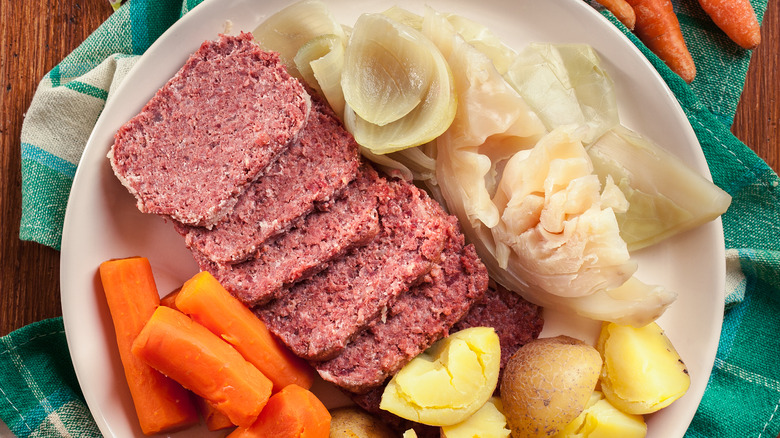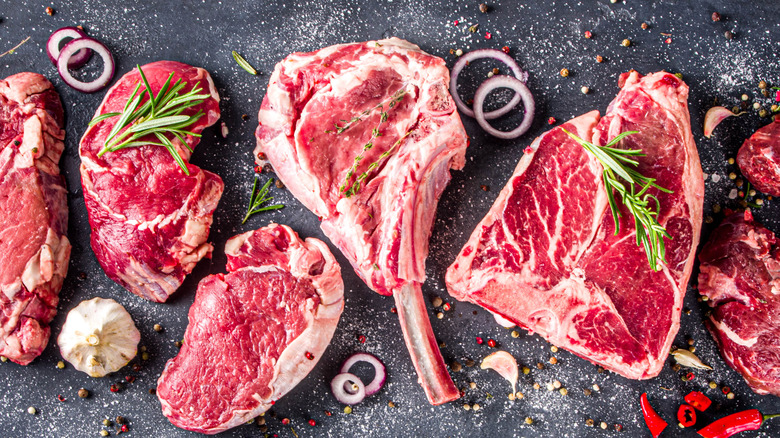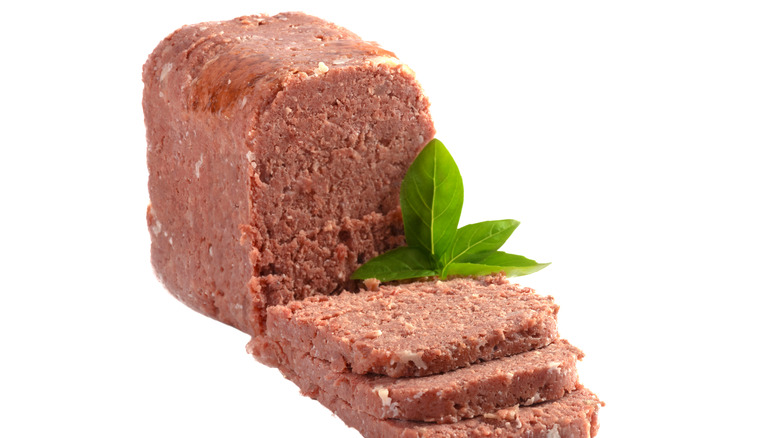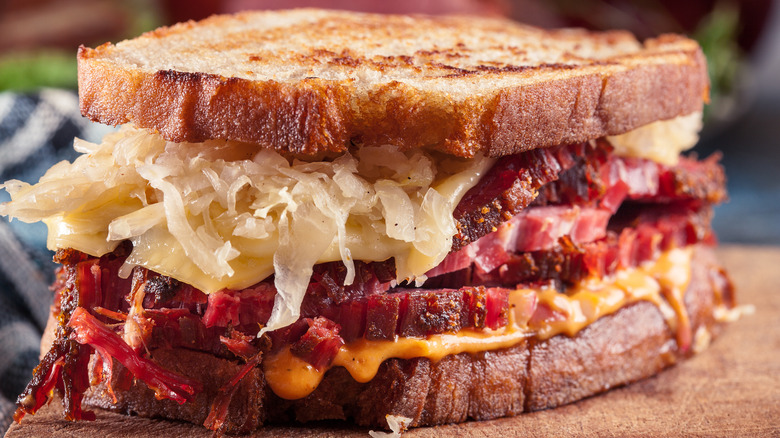The Untold Truth Of Canned Corned Beef
If you grew up in America, your only exposure to canned corned beef might have come in the form of a weekend breakfast of corned beef hash. In an era when refrigeration allows fresh meat to be shipped all over the world without spoiling, the salty, gelatinous mush packed into a tin doesn't hold the same appeal that it used to. Nevertheless, canned salted beef still has legions of fans, and it continues to help people all over the world cope with the food shortages and geographical displacement caused by war and natural disaster.
In its heyday, canned corned beef was considered cutting-edge. Like many groundbreaking technologies, it was developed using military-funded research and only entered the civilian realm as a side effect of its military popularity. Canned corned beef is like the Forrest Gump of the food world, showing up in almost every important historical event of the late 19th and early 20th centuries. Although historically, it's been a food associated with deprivation, its wide cultural reach has turned it into a nostalgic treat in a variety of cultures. This is how canned corned beef took over the world.
It has nothing to do with corn
Corned beef's name is a little bit confusing, as the product contains no corn. Rather, the "corned" in the name refers to the rock salt used to preserve the beef (via The Kitchen Project). The word "corn" comes from "kurnam," the proto-Germanic word for a seed or piece of grain. According to Bon Appétit, English speakers used "corn" as a generic name for any type of grain long before they encountered maize in the New World. When indigenous people in the Americas showed Europeans their staple crop, the colonists initially dubbed it "Indian corn," a name that stuck until the 19th century.
Large chunks of rock salt are roughly the size of a kernel of grain, so they came to be called salt corns. This use of the word is very old, with the first written instance of "corned" dating back to the 800s. Smithsonian Magazine notes that English importers started to use the word "corned beef" to describe Irish salted meat in the 1600s. That means corned beef had its name for almost two centuries before Americans started calling maize "corn."
It was used as a kosher substitute for Spam
Spam has an illustrious history as a military ration, with the U.S. Armed Forces feeding 150 million pounds of the canned ham product to its troops during WWII (via Smithsonian Magazine). Canned meat doesn't require refrigeration and can be eaten without cooking, so it has obvious advantages for combat use.
So how did Spam lead to the popularity of canned corned beef? According to The Jewish News, the Israeli Defense Forces wanted to feed tinned meat to their conscripts, but they had a problem: Spam wasn't kosher. After World War II, the IDF developed its own kosher canned corned beef called Loof (short for "meatloaf"). It continued to serve Loof to soldiers through the early 21st century because the product could last decades if stored correctly. One Israeli soldier said in 2011 that he ate a can of Loof made before he was born. It turns out, age hadn't affected the Loof at all, and in the words of the soldier, "It wasn't bad."
Israel isn't the only military that relied on canned corned beef. The British fed it to their fighting men from the 19th century through WWII (via We Are Not Foodies).
The rectangular can was designed to save space
The familiar rectangular or trapezoidal corned beef can that U.S. consumers are familiar with was patented in Chicago by Arthur A. Libby in 1875 (via The Food Timeline). Jen Evansy at FoodHow writes that the distinctive shape allows corned beef cans to stack more efficiently than round cans. This made it ideal for the military, as it reduced shipping costs. Although corned beef's heyday as an army food is now decades in the past, manufacturers haven't found a reason to mess with a formula that has worked for over 100 years.
A perfectly rectangular can would stack just as well as a trapezoidal can, but the irregular shape of a corned beef tin serves a purpose besides conserving space. The fact that the can is wider on the side you open allows the delicate minced meat to slide out of its package without breaking. Despite the advantages of this can design, no other product has adopted the trapezoidal tin. If you see that can on a shelf, you know exactly what's going to be inside it.
It's a breakfast staple in the Philippines
Although corned beef has its roots in Europe, the Philippines might love it more than any other country (via Vice). Canned corned beef is one of the most popular breakfast foods there, filling a similar cultural role to bacon in the U.S. The combination of fried corned beef, white rice, and eggs is a classic Filipino breakfast, made by millions of home cooks every day. Part of the country's affection for the product might be that their version is better than the kind available in most of the world. Outside of the Philippines, most canned corned beef is made from finely minced meat. Filipinos use a brand from New Zealand called Palm that's made of shredded beef and has a texture similar to pulled pork.
Although corned beef isn't as popular in the U.S. as it is in the Philippines, it's still a fairly common breakfast option stateside. The Nibble reports that in America, most canned corned beef is consumed in the form of corned beef hash, a midcentury diner favorite that combines minced salt beef with diced potatoes and other seasonings.
Corned beef is not a traditional Irish food
Ireland has a long history of raising cattle for dairy production, but beef has not traditionally been a popular meat in the region. The ancient pre-Christian Gaelic religion believed cows were sacred, and most Irish farmers preferred to keep their cows alive to produce milk rather than slaughtering them. Expensive beef was mostly consumed by the highest levels of ancient Irish society, with most of the country's residents eating pork as their animal protein of choice (via Food and Wine).
Ireland didn't produce beef on a mass scale until it was conquered by England in the 1500s and the English conquerors started raising cattle to export back home. The English Parliament forbade the exportation of fresh beef from Ireland in the 17th century, so landowners switched to selling corned beef which, as a preserved product, was exempt from the new law. As a result, the Irish city of Cork dominated global corned beef production for almost two centuries. Even though the majority of the world's corned beef came from Ireland, most Irish citizens avoided it because of its high price. People of Irish heritage only started eating corned beef in large numbers once they emigrated to the U.S. in the wake of the Potato Famine. Ironically, it was more affordable to buy across the Atlantic Ocean than it was at home.
Guns were used as can openers
We have the French Revolution to thank for the invention of canned food. The revolutionary government sought a way to deliver food to its troops at home and abroad while avoiding spoilage. Multi-hyphenate kitchen innovator Nicholas Appert figured out that food boiled for five hours in sealed containers would stay fresh indefinitely.
The British wasted almost no time in stealing Appert's idea, patenting an improvement to his method in 1810, the same year he publicized his new technology. While Appert relied on glass jars, the British used iron canisters coated with tin to make them rust-resistant. The metal cans were lighter and more durable than the glass jars.
There was only one problem: No one invented a tool to open the new cans. The first patent for a can opener in the U.S. is from 1858, over 40 years after canned food had become a popular military ration. Before that, cans came with instructions that told users to open with a hammer and chisel. Sometimes, desperate servicemen would shoot their corned beef to get it open. The hassle of prying open early cans was enough to discourage average citizens, who avoided canned food in their home cooking. When the first self-opening corned beef can debuted in 1866, it paved the way for corned beef to become a household staple instead of merely a wartime necessity.
Colonialism spread corned beef throughout the world
Modern corned beef production was spurred by the English conquest of Ireland, and the British Empire spread the product across many of the regions it ruled (via Smithsonian Magazine). The English rulers of Ireland made so much money from selling salted beef that they were even permitted to sell it to England's enemy, France. Both the French and the English supplied their colonial holdings with corned beef, exporting it to Africa and the Americas (via We Are Not Foodies).
As Time notes in an exploration of the history of Spam in Asia, former colonies have a fraught relationship with the canned meats that were introduced by conquering powers. Canned meat often showed up in tandem with violence, but it also served as vital sustenance during lean times. In an era when many people in the countries that invented canned meat view it with disdain, cooks in places like the Philippines embrace canned corned beef as an integral part of the national food identity (via Vice). In recent years, Western consumers have embraced the delicious canned meat recipes that Asian cooks innovated because of necessity.
South America holds a virtual monopoly on canned corned beef production
Recipe Reminiscing notes that Irish corned beef production diminished at the end of the 19th century. By the start of WWII, South America had replaced Ireland as the leading producer of corned beef. During the first half of the 20th century, Uruguay led the way, making 16 million tins of corned beef in 1943. Brazil now produces more canned corned beef than all other countries combined.
The drive to produce more cattle for corned beef is a leading contributor to Amazon deforestation in Brazil (via EarthSight). Cattle ranchers who raise meat for Brazilian firm JBS have been linked to the illegal destruction of large swathes of the Amazon rainforest. Not only that, but the Brazilian government alleges that JBS-affiliated rancher Jotinha staffs his ranches with workers who toil under slave-like conditions. Deforestation and labor violations aren't the only recent Brazilian corned beef scandals. Dig Jamaica reports that Jamaica joined several other countries in temporarily banning all imports of Brazilian corned beef in 2017. The ban was triggered after an investigation found that some Brazilian meat producers had been selling spoiled products and paying off inspectors to avoid detection.
It's hard to tell what part of the cow it's made from
Deli-style sliced corned beef is typically made from beef brisket, but the cuts of meat used for the canned stuff are mysterious. A breakdown of the nutritional content of Hormel corned beef on Innit reveals that the product contains just six ingredients. The list is surprisingly short for a shelf-stable processed food, consisting mostly of stuff you would recognize from a home kitchen, with a couple of preservatives added. Despite this apparent simplicity, the "beef" component of the recipe could come from almost any part of the cow, including some cuts that people don't customarily eat as food in the U.S.
According to My Fearless Kitchen, U.S. Law permits products labeled as beef to contain diaphragm, esophagus, blood vessels, nerves, sinew, and skin. It's not allowed to "include significant portions of bone," but it's permissible to have "the portions of bone ... which normally accompany the muscle tissue." No amount of brain is allowed in beef due to the risk of mad cow disease. These rules give a lot of wiggle room for meatpackers to decide what exactly the "beef" in corned beef is composed of, although they do exclude organ meats like liver, lungs, and tripe. You might be hesitant to consume mystery meat like canned corned beef, but if you've ever eaten a hot dog or a Slim Jim you've likely already eaten parts of an animal you would never cook at home.
The nitrites in corned beef might be a carcinogen
Like most cured meats, canned corned beef uses a small amount of sodium nitrite as a preservative (via Innit). The BBC explains that sodium nitrite helps kill bacteria during the curing process, allowing the meat to be safely stored at room temperature. The chemical also changes the color of the meat, making it stay pink even when fully cooked. Although the nitrites in cured meats protect us from food poisoning, they may have negative long-term health effects.
When nitrites react with amines, a type of chemical found in protein-rich foods, they form nitrosamines. Research links certain nitrosamines to an increased risk of cancer (via BBC). However, it's not clear how much the nitrites in cured meats contribute to cancer risk. People who consume a moderate amount of preserved meat every day are only slightly more likely to develop cancer, and nitrites aren't the only potential carcinogen lurking in red meat. Furthermore, most of the nitrites in a typical person's diet occur in vegetables rather than meats. These nitrites may actually improve cardiovascular fitness. The health effects of nitrites are complex, and more research is necessary to unpack their risks and potential benefits. That said, corned beef is still best enjoyed as an occasional treat, as it contains big doses of sodium and saturated fat in addition to the nitrites.
Corned beef is partially responsible for pumpkin pie
Libby's canned pumpkin starts taking over supermarket shelves when the leaves turn, satisfying Americans' annual autumnal cravings for pumpkin desserts. Although you can cook and puree your own pumpkin to make pie, most people rely on the ease and consistent flavor of the canned stuff. Libby's is made from a special variety of squash called Dickinson pumpkin that can only be grown in the region around Morton, Illinois (via Medium). This extra-sweet pumpkin makes for the perfect pie filling.
But before it was it in the pumpkin business, the Libby's corporation started as a corned beef canning operation run by Arthur and Charles Libby, along with their business partner Archibald McNeil (via Libby's International). Founded in 1868, the company pioneered many innovations in the canned beef industry including the tapered can and refrigerated trucks. The company began branching out into other canned goods in the early 1900s, selling sauerkraut, A1 Sauce, fruits, and vegetables. Libby's bought the company behind canned Dickinson pumpkin in 1930, and it's been known by the Libby's name ever since.
Deli corned beef and canned corned beef evolved independently
As we've discussed already, the British invented canned corned beef as a way to preserve and export Ireland's cattle in the early 19th century. Jewish deli corned beef, the sliced, cured brisket you order piled high on rye with spicy mustard, has a much older history. Curing meat in brine has been a Jewish tradition since ancient Hebrews started pickling meat to eat during Tisha B'Av, a commemoration of the destruction of the Temple in Jerusalem (via Serious Eats). At the time, priests thought that the curing process made the meat less celebratory and more suitable for the somber holiday.
This tradition of cured red meat continued all the way through the 1800s, when Jewish Germans ran delicatessens inspired by the charcuterie shops of France. When German Jews began fleeing en masse to America to avoid persecution in their home country, they opened delis all over the U.S. that served corned beef brisket. These Jewish immigrants often settled in neighborhoods close to Irish migrants who had escaped the Potato Famine. The Irish, many of whom had been workers in the corned beef industry before they immigrated, began buying corned beef brisket from Kosher butchers, solidifying it as "Irish" food in the American imagination (via Smithsonian Magazine).
